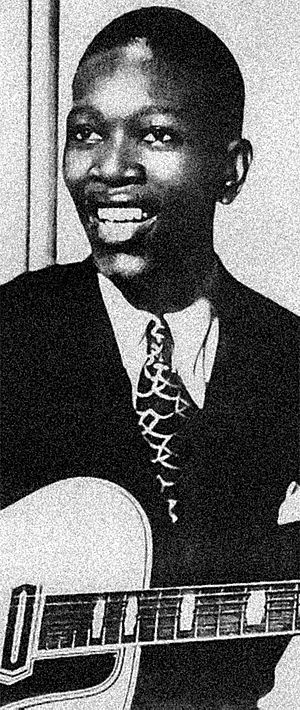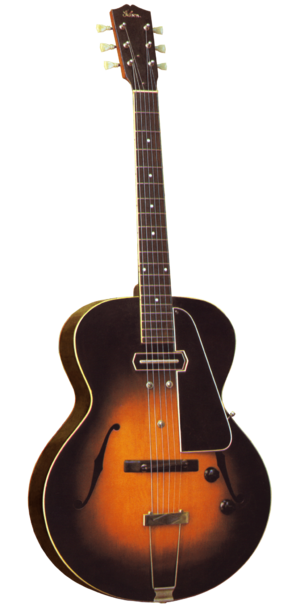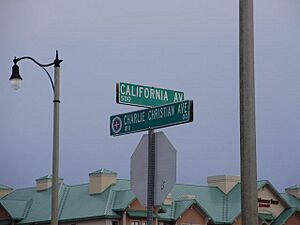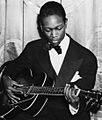Charlie Christian facts for kids
Quick facts for kids
Charlie Christian
|
|
|---|---|
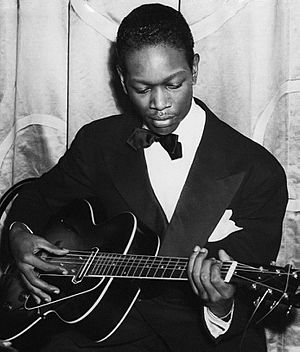
Christian performing at the Waldorf Astoria New York, October 1939
|
|
| Background information | |
| Birth name | Charles Henry Christian |
| Born | July 29, 1916 Bonham, Texas, U.S. |
| Died | March 2, 1942 (aged 25) Staten Island, New York |
| Genres | Jazz, swing |
| Occupation(s) | Musician |
| Instruments | Guitar |
| Associated acts | Benny Goodman |
Charles Henry Christian (born July 29, 1916 – died March 2, 1942) was an American swing and jazz guitarist. He was a very important early player of the electric guitar. Many people see him as a key figure in the start of bebop and cool jazz music.
Christian became famous when he joined the Benny Goodman Sextet and Orchestra. He played with them from August 1939 to June 1941. His special way of playing single notes, along with using an amplified guitar, helped the guitar become a main solo instrument. Before him, the guitar was mostly used for rhythm. Because of this, he is often given credit for creating the role of the lead guitar in bands.
Famous music experts like John H. Hammond and George T. Simon called Christian the best improviser of the swing era. Gene Lees wrote that many musicians believe Christian was one of the founders of bebop.
Christian's influence went beyond just jazz and swing music. In 1990, he was added to the Rock and Roll Hall of Fame as an "Early Influence." The famous guitarist Jerry Garcia said Christian and Django Reinhardt were the two guitarists who inspired him most.
In 2006, a street in Oklahoma City was renamed "Charlie Christian Avenue." Christian grew up in Oklahoma City. He was one of many musicians who played music in the city's "Deep Deuce" area.
Contents
Early Life and Musical Beginnings
Christian was born in Bonham, Texas. His family moved to Oklahoma City, Oklahoma, when he was very young. Both of his parents were musicians. He had two older brothers, Edward and Clarence. Their father, Clarence Henry Christian, taught all three sons about music.
His father became blind from a fever. To support the family, he and the boys worked as buskers. They would perform music in nice neighborhoods for money or goods. When Charles was old enough, he first danced to entertain people. Later, he learned to play the guitar. He got his father's instruments after his father died when Charles was 12.
He went to Douglass School in Oklahoma City. There, his music teacher, Zelia N. Breaux, encouraged him. Charles wanted to play the tenor saxophone in the school band. But his teacher wanted him to try the trumpet. He thought playing the trumpet would hurt his lip, so he quit music to play baseball. He was very good at baseball.
In the 1920s and 1930s, Charles's brother Edward led a band in Oklahoma City. Around 1931, Edward's bandmate, "Bigfoot" Ralph Hamilton, secretly taught Charles about jazz. They taught him how to play solos on three songs: "Rose Room", "Tea for Two", and "Sweet Georgia Brown".
When Charles was ready, they took him to a late-night jam session. These sessions happened on Northeast Second Street, known as "Deep Deuce" in Oklahoma City. Edward didn't want Charles to play at first. But after some encouragement, he let Charles play. Charles played all three songs he knew, and everyone was amazed. His mother heard about his amazing performance before he even got home!
Charles soon started performing locally. He also traveled and played throughout the Midwest. By 1936, he was playing electric guitar. He became a popular musician in his region. He jammed with many famous musicians who visited Oklahoma City. These included Teddy Wilson and Art Tatum. Mary Lou Williams, a pianist, told record producer John H. Hammond about Christian.
Becoming Nationally Famous

In 1939, Christian tried out for John Hammond. Hammond then suggested him to the bandleader Benny Goodman. Goodman was one of the first white bandleaders to have black musicians in his live band. He had already hired Teddy Wilson and Lionel Hampton. Goodman hired Christian to play with his new Goodman Sextet in September 1939.
Some people say Goodman wasn't sure about hiring Christian at first. The electric guitar was a new instrument then. But Goodman was so impressed by Christian's playing that he hired him.
There are different stories about their first meeting on August 16, 1939. Their first try at a recording studio didn't go well. Christian said, "I guess neither one of us liked what I played." But Hammond decided to try again without telling Goodman.
Hammond put Christian on stage for that night's show. Goodman was surprised and called out "Rose Room." He thought Christian wouldn't know the song. But Christian knew it well! He played about twenty different solos, all amazing and new to Goodman. That version of "Rose Room" lasted forty minutes. By the end, Christian was officially in the band. In just a few days, Christian went from earning $2.50 a night to $150 a week.
Christian joined Goodman's new sextet. This group included Lionel Hampton, Fletcher Henderson, Artie Bernstein, and Nick Fatool. By February 1940, Christian was the top jazz and swing guitarist in music polls. He was also chosen for the Metronome All Stars band.
In 1966, 24 years after he died, Christian was added to the Down Beat Jazz Hall of Fame. In 1989, the Oklahoma Jazz Hall of Fame started. Christian was one of the first seven people to be honored there.
Christian's Unique Style and Influences
Christian's guitar solos often sounded like horn players. He was more influenced by horn players like Lester Young and Herschel Evans. He wanted his guitar to sound like a tenor saxophone. Early guitarists like Eddie Lang and Lonnie Johnson had helped the guitar become a solo instrument. But Christian took it even further.
By 1939, there were already other electric guitar soloists. These included Leonard Ware and Floyd Smith. But Christian really opened the door for the modern electric guitar sound. Other famous guitarists followed his path. These include T-Bone Walker, B.B. King, Chuck Berry, Carlos Santana, and Jimi Hendrix. This is why Christian was inducted into the Rock and Roll Hall of Fame in 1990.
Christian's impact was huge, even though he played with Goodman for only a short time. He influenced not only guitarists but also other musicians. His influence can be heard in the early bop recordings of "Dizzy" Gillespie, Charlie Parker, and Thelonious Monk. Other musicians, like trumpeter Miles Davis, also said Christian influenced them. Christian's "new" sound changed jazz music as a whole. He remained the top jazz guitarist in polls for two years after his death.
Bebop and Minton's Playhouse
Christian was a very important part of the music that became known as bop, or bebop. Some musicians who were at the early late-night jam sessions at Minton's Playhouse say Christian even helped name "bebop." They say he hummed musical phrases that sounded like "bebop."
In September 1939, some private recordings were made in Minneapolis, Minnesota. These recordings featured Christian, Goodman's sax player Jerry Jerome, and bassist Oscar Pettiford. Christian took many solos in these recordings. They show he was already a very skilled musician. These recordings include "Stardust", "Tea for Two", and "I've Got Rhythm". "I've Got Rhythm" was a favorite song for bebop composers and jam sessions.
More examples of Christian's bebop playing can be heard in recordings from Minton's Playhouse. This was a late-night club in Harlem. A student named Jerry Newman recorded these sessions in 1941. Christian played with Joe Guy on trumpet, Kenny Kersey on piano, and Kenny Clarke on drums.
Christian used a technique called "tension and release" in his music. This was also used by Lester Young and Count Basie. You can hear this in "Stompin' at the Savoy" from the Newman recordings. The collection also has recordings from Clark Monroe's Uptown House. This was another late-night jazz spot in Harlem.
Kenny Clarke said that "Epistrophy" and "Rhythm-a-Ning" were Christian's songs. Christian played them with Clarke and Thelonious Monk at Minton's jam sessions.
These recordings have been released under many different names. Even though the sound quality is often not great, they show Christian playing much longer solos than he could on the Benny Goodman records. In the Minton's recordings, Christian plays many choruses on one song. He shows how easily he could create long, flowing musical ideas.
Christian was also good at playing with simple, well-placed notes. His work on songs like "Soft Winds" and "A Smo-o-o-oth One" shows this. His playing on ballads like "Stardust" and "Memories of You" also hinted at what would later be called cool jazz. Christian wrote many of the original songs recorded by the Benny Goodman Sextet, even though he didn't always get credit for them.
Health and Early Death
In the late 1930s, Christian got tuberculosis. In early 1940, he was in the hospital for a short time. The Goodman group was also on a break because Goodman had back problems.
Christian went home to Oklahoma City in July 1940. He returned to New York City in September 1940. In early 1941, Christian went back to his busy life. He would finish his shows with the Goodman Sextet and Orchestra. Then he would go to Harlem for late-night jam sessions.
In June 1941, he was admitted to Seaview, a sanitarium on Staten Island in New York City. People thought he was getting better. DownBeat magazine even reported in February 1942 that he and Cootie Williams were starting a new band.
However, after a visit to the hospital that same month, Christian's health got worse. He died on March 2, 1942, when he was only 25 years old. He was buried in an unmarked grave in Bonham, Texas. In 1994, a Texas State Historical Commission Marker and a headstone were placed in Gates Hill Cemetery. The exact spot of his grave was debated, but in 2013, it was recognized that Christian is buried under a concrete slab there.
Instruments Charlie Christian Played
- Epiphone Deluxe guitar (an acoustic archtop guitar), 1934–1937
- Gibson ES-150 guitar (a sunburst color, with dots on the fingerboard), and EH-150 amplifier, 1937 or 1939 – April 1940
- Gibson ES-250 guitar (custom made by Gibson with a natural wood finish), April 1940 – February 1941. This guitar was found again in 2002.
- Gibson ES-250 guitar (custom made by Gibson with a natural wood finish and special designs on the fingerboard), February 1941 – March 1942
- Gibson L-5 guitar (custom made by Gibson with a "Charlie Christian pickup" instead of a P-90). This guitar was given to Christian just before he died in March 1942.
The special bar-shaped pickup used on the ES-150 and ES-250 guitars became known as the "Charlie Christian pickup."
Music Recordings (Discography)
Charlie Christian never released music as the main artist. But many collections have been put out. These include his recordings as a sideman where he plays solos. There are also practice recordings and some lower-quality recordings of his own groups playing in clubs.
With Benny Goodman
- Charlie Christian with the Benny Goodman Sextet and Orchestra (Columbia, 1955)
- Solo Flight: The Genius of Charlie Christian (Columbia, 1972)
- The Genius of the Electric Guitar, 1939–1941 recordings (Columbia, 1987)
- The Benny Goodman Sextet Featuring Charlie Christian 1939–41 (Columbia, 1989)
- Solo Flight, with the Benny Goodman Sextet (Vintage Jazz Classics, 1991)
- Guitar Wizard (Le Jazz/Charly, 1993)
- Complete Studio Recordings (Definitive, 2000) 4-CD box set
- Complete Live Recordings (Definitive, 2001) 4-CD box set
- Radioland 1939–1941 (Fuel 2000/Varèse Sarabande, 2001)
- The Genius of the Electric Guitar (Columbia/Legacy, 2002) 4-CD box set
- First Master of the Electric Guitar: Selected Broadcasts & Jam Sessions, Remastered (JSP, 2002) 4-CD box set
- Charlie Christian – The Original Guitar Genius (Proper, 2005) 4-CD box set
- The Genius of the Electric Guitar (Definitive, 2005)
- Solo Flight: Live! with the Benny Goodman Sextet (Definitive, 2008)
- On the Air (Fuel 2000/Varèse Sarabande, 2009)
- Yale University Archives, Vol. 5: NBC Broadcast Recordings 1936-1943 (Nimbus, 2010)
- Electric, with the Benny Goodman Sextet and the Charlie Christian Quartet (Uptown, 2011)
With Lionel Hampton
- The Complete Lionel Hampton 1937–1941 (Bluebird, 1976) 6-LP box set
With others
- From Spirituals to Swing – Carnegie Hall Concerts 1938/39 (Vanguard, 1959) 2-LP
Filmography
- 2005 Solo Flight: The Genius of Charlie Christian
- 2007 Charlie Christian- The Life & Music of the Legendary Jazz Guitarist (Grossman Guitar Workshop)
Images for kids
See also
 In Spanish: Charlie Christian para niños
In Spanish: Charlie Christian para niños


